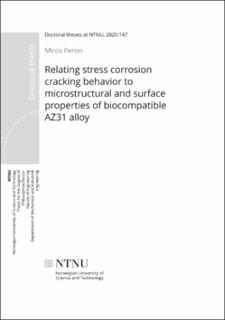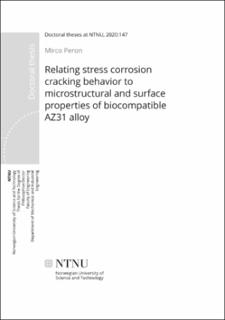| dc.contributor.advisor | Torgersen, Jan | |
| dc.contributor.advisor | Berto, Filippo | |
| dc.contributor.author | Peron, Mirco | |
| dc.date.accessioned | 2020-04-28T14:05:42Z | |
| dc.date.available | 2020-04-28T14:05:42Z | |
| dc.date.issued | 2020 | |
| dc.identifier.isbn | 978-82-326-4643-2 | |
| dc.identifier.issn | 1503-8181 | |
| dc.identifier.uri | https://hdl.handle.net/11250/2652810 | |
| dc.description.abstract | Magnesium (Mg) and its alloys have attracted significant attention as temporary implant materials due to their excellent biocompatibility with human physiology. In fact, Mg is essential to the human metabolism as a cofactor for many enzymes and Mg ions are well-known to facilitate tissue-healing. In addition, the mechanical properties (density, elastic modulus, yield strength and ultimate tensile strength) of Mg and its alloys resemble those of natural bone reducing the risk of the stress-shielding-related problems observed with other metallic implant materials such as stainless steel, titanium and Co-Cr alloys. However, despite their high potential, Mg and its alloys are not yet utilized in biomedical applications. This is due to the (1) rapid corrosion and degradation in the human body that leads to a loss of mechanical integrity before tissues have sufficient time to heal, (2) the evolution of hydrogen as corrosion product accompanied by hydrogen pocket formation that hampers healing or even cause the death of patients through the blockage of the blood stream and (3) the sudden fracture of implants due to the simultaneous action of the corrosive human-body-fluid and mechanical loads through corrosion-assisted cracking phenomena (stress corrosion cracking (SCC) and corrosion fatigue (CF)).
In the past years, several approaches have been developed to improve the corrosion resistance of Mg and its alloys. These approaches can be divided into two main groups, one characterized by the modification of the bulk and the other by the modification of the surface. Among the former, Severe Plastic Deformation (SPD) techniques, such as Equal Channel Angular Pressing (ECAP), have attracted attention as possibility for inducing a very fine and homogeneous microstructure throughout all the samples. The latter group relies on surface modifications obtained by mechanical processing (e.g. cryogenic machining) or by the protection through coatings deposited by various techniques (e.g. sputter and Atomic Layer Deposition (ALD)). However, the assessment of the effectiveness of the different approaches in improving the resistance of Mg and its alloys to corrosion-assisted cracking phenomena is still underexplored.
In an attempt to understand the fundamental mechanisms linking the microstructural and surface properties to the SCC susceptibility, this thesis investigates how selected procedures initially intended for improving the corrosion resistance of Mg and its alloys impact the SCC susceptibility of AZ31 alloys in Simulated Body Fluid (SBF) at 37 °C. The procedures selected from an extensive literature review investigating the different procedures used to improve the corrosion behavior and the mechanisms regulating the SCC phenomenon were ECAP, cryogenic machining and coatings obtained by means of ALD.
1, 2 and 4 passes of ECAP were carried out on an AZ31 alloy and samples subjected to one pass of ECAP have been shown to be less susceptible to SCC compared to the material in the as-received condition (the elongation to failure was increased by 150%) due to the improved corrosion resistance as a consequence of a reduced grain size. The reduced SCC susceptibility after one pass of ECAP was also confirmed by the morphology of the fracture surfaces that reveals an increased ductility compared to the as-received material. However further ECAP processing (2 and 4 passes) are reported to worsen the SCC susceptibility due to an increased brittleness of the material as a consequence of an increased amount of hydrogen evolved. This is due to the unfavorable texture evolution, as confirmed by the mechanical characterization (tensile tests and hardness measurements).
AZ31 samples were machined under cryogenic cooling and afterwards subjected to Slow Strain Rate Tests (SSRTs) at a strain rate of 3.5·10-6 s-1 to evaluate the SCC susceptibility. Cryogenic machined samples were characterized by lower SCC susceptibility than dry cut samples (the elongation to failure was increased by 28%) as a consequence of their improved corrosion performances due to the presence of a wider nanocrystalline layer, resulting in a faster formation of passivating surface oxides, and to the presence of compressive residual stresses instead of tensile.
Being ALD a recently developed technique still underexplored in terms of corrosion and biological properties, it was compared to sputter technique in terms of corrosion protectiveness and the induced biocompatibility of three different coatings were evaluated. The ALD technique has been shown to provide the better corrosion protection (assessed by means of potentiodynamic polarization curves and hydrogen evolution experiments) both in case of smooth and rough surfaces due to an increased surface integrity (observed by SEM and XPS analyses). In addition, in the case of 3D porous structures, the improvements provided by the ALD technique were even higher as a consequence of the line-of-sight limitation of sputtering (confirmed by means of SEM analyses). In addition, the biocompatibility of TiO2, ZrO2 and HfO2 coatings obtained by means of ALD have been investigated by means of MTS assay on L929 cells and the HfO2 coatings were shown to provide the best biocompatibility due to the highest corrosion resistance. This can be reasoned by their lower wettability and their higher electrochemical stability and surface integrity (in terms of cracks and pores). TiO2, though generally considered a biocompatible coating, was found to provide the lowest improvements in terms of corrosion resistance and cell viability. Interestingly, TiO2 coatings are characterized by grade 3 cytotoxicity after 5 days of culture due to their high corrosion rate, which does not meet the demands for cellular applications. These results indicate the strong link between biocompatibility and corrosion protection and signify the need of considering the latter when choosing a biocompatible coating to protect temporary Mg based alloys before implantation.
Finally, the SCC susceptibility of TiO2 and ZrO2 ALDed coated AZ31 alloys have been evaluated and the ZrO2 coated samples were reported to have the lowest SCC susceptibility. In fact, the elongation to failure of the TiO2 coated samples were increased by 125% and that of ZrO2 coated samples by 220%. The different SCC susceptibility was attributed to the improved corrosion of the ZrO2 coated samples compared to the TiO2 coated samples as a consequence of four main aspects, i.e. different cohesive energies, different wettability, different defect densities and sizes and different mechanical properties. | en_US |
| dc.language.iso | eng | en_US |
| dc.publisher | NTNU | en_US |
| dc.relation.ispartofseries | Doctoral theses at NTNU;2020:147 | |
| dc.relation.haspart | Paper 1: Peron, Mirco; Torgersen, Jan; Berto, Filippo. Mg and its alloys for biomedical applications: Exploring corrosion and its interplay with mechanical failure. Metals 2017 ;Volum 7.(252)
https://doi.org/10.3390/met7070252
This is an open access article distributed under the Creative Commons Attribution License (CC BY 4.0) | en_US |
| dc.relation.haspart | Paper 2:
M. Perona, P. C. Skaretb, A. Fabrizic, R. Montanarid, H. J. Rovenb, P. Ferroc, F. Bertoa,
J. Torgersena
The effect of Equal Channel Angular Pressing on the stress corrosion cracking susceptibility of AZ31 alloy in simulated body fluid.
Journal of the Mechanical Behavior of Biomedical Materials
Volume 106, June 2020, 103724
https://doi.org/10.1016/j.jmbbm.2020.103724
This is an open access article distributed under the Creative Commons Attribution License (CC BY 4.0) | |
| dc.relation.haspart | Paper 3: Peron, Mirco; bertolini, rachele; ghiotti, andrea; Torgersen, Jan; bruschi, stefania; Berto, Filippo. Enhancement of stress corrosion cracking of AZ31 magnesium alloy in simulated body fluid thanks to cryogenic machining. Journal of The Mechanical Behavior of Biomedical Materials 2020 ;Volum 101 https://doi.org/10.1016/j.jmbbm.2019.103429 | |
| dc.relation.haspart | Paper 4: M. Peron, A. Bin Afif, A. Dadlani, F. Berto, J. Torgersen On the comparison between the corrosion performances of sputtered and ALDed TiO2 thin layer with different substrate roughness and topology | |
| dc.relation.haspart | Paper 5: M. Perona, S. Cogob, M. Bjellanda, A. Bin Afifa, A. Dadlania, E. Greggiob, F. Bertoa, J. Torgersena On the evaluation of ALD TiO2, ZrO2 and HfO2 coatings on corrosion and cytotoxicity Performances | |
| dc.relation.haspart | Paper 6: M. Peron, A. Bin Afif, A. Dadlani, F. Berto, J. Torgersen Effect of titania and zirconia ALD coating on stress corrosion cracking susceptibility of AZ31 alloy in simulated body fluid | |
| dc.relation.haspart | Book: Mirco Peron, Filippo Berto, Jan Torgersen. Magnesium and Its Alloys as Implant Materials: Corrosion, Mechanical and Biological Performances CRC Press, https://doi.org/10.1201/9781003000327 | |
| dc.title | Relating stress corrosion cracking behavior to microstructural and surface properties of biocompatible AZ31 alloy | en_US |
| dc.type | Doctoral thesis | en_US |
| dc.subject.nsi | VDP::Technology: 500::Mechanical engineering: 570 | en_US |

